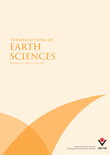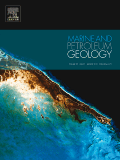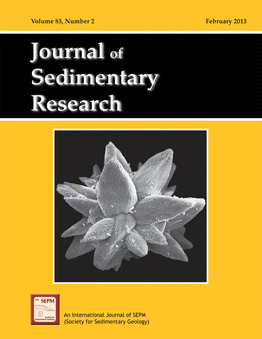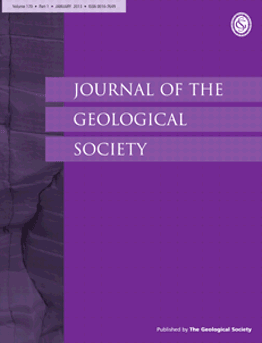
Journal of Sedimentary Environments
Scope & Guideline
Connecting Researchers to Shape the Future of Sedimentary Studies.
Introduction
Aims and Scopes
- Sedimentology and Stratigraphy:
The journal primarily addresses the processes of sediment deposition, transport, and diagenesis, including the analysis of sedimentary structures and facies. This includes both clastic and carbonate systems. - Paleoenvironmental and Paleoclimatic Studies:
Research often emphasizes the reconstruction of past environments and climates based on sedimentary records, including the use of geochemical proxies and fossil assemblages to interpret historical ecological conditions. - Petroleum Geology and Hydrocarbon Potential:
A significant focus is placed on the exploration and evaluation of sedimentary basins for hydrocarbon resources, including studies on source rocks, reservoirs, and the geochemical characterization of sediments. - Geochemistry and Mineralogy:
The journal also covers the geochemical analysis of sediments and rocks, including the investigation of mineralogical composition and its implications for provenance, weathering processes, and environmental change. - Soil Erosion and Conservation:
Another aspect is the study of soil erosion dynamics, conservation strategies, and the impacts of land use changes on sediment yield, with applications in environmental management and sustainability.
Trending and Emerging
- Integrated Geophysical and Geochemical Approaches:
There is a growing trend towards integrating geophysical methods with geochemical analyses to better understand subsurface characteristics, hydrocarbon potential, and sediment dynamics. - Impact of Climate Change on Sedimentary Processes:
Research increasingly focuses on how climate change affects sediment transport, erosion, and deposition, reflecting the urgency of understanding these impacts in the context of global environmental change. - Advanced Remote Sensing Techniques:
The application of remote sensing technologies, such as satellite imaging and GIS, for sediment analysis and environmental monitoring is becoming more prevalent, providing new insights into sedimentary processes over large spatial scales. - Microplastics and Environmental Contaminants:
There is an emerging focus on the study of microplastics and other contaminants within sedimentary environments, highlighting the importance of understanding anthropogenic impacts on sediment quality and ecosystem health. - Interdisciplinary Approaches to Sediment Management:
Research increasingly emphasizes interdisciplinary methodologies that combine sedimentology with ecological, hydrological, and socio-economic perspectives to address complex environmental challenges.
Declining or Waning
- Traditional Biostratigraphy:
While biostratigraphy remains an important tool, there has been a noticeable decline in studies focused solely on traditional biostratigraphic methods without integrating modern geochemical or molecular techniques. - Classic Sediment Transport Models:
Research employing older sediment transport models without adaptations to contemporary findings and technologies has become less frequent, as there is a growing preference for more integrated, multi-faceted approaches. - Static Paleoenvironmental Reconstructions:
Studies that provide static or singular reconstructions of past environments without considering dynamic changes and feedbacks over time have been decreasing, as newer methodologies emphasize the complexity and variability of sedimentary systems.
Similar Journals

Swiss Journal of Geosciences
Bridging Knowledge Gaps in Earth and Planetary SciencesSwiss Journal of Geosciences is a prestigious academic journal dedicated to advancing the field of geosciences, published by SPRINGER INTERNATIONAL PUBLISHING AG. Since its inception in 2007, the journal has established itself as a leading platform for disseminating high-quality research findings in various domains related to Earth and planetary sciences, achieving a notable Q1 ranking in Geology as of 2023. With a solid reputation reflected in its Scopus ranking of Rank #72/321, the journal stands in the 77th percentile within its category. Based in Switzerland, the Swiss Journal of Geosciences embraces an open access model, making it easier for researchers, professionals, and students worldwide to access vital geological research without barriers. The journal’s objectives include promoting interdisciplinary research and fostering insights that address both fundamental and applied geoscientific problems, ensuring it remains a crucial resource for those seeking to understand our planet’s dynamics. Engage with pioneering research and contribute to the vibrant community of geoscientists by exploring the impactful articles published within its pages.

TURKISH JOURNAL OF EARTH SCIENCES
Catalyzing Scholarly Discourse in Earth SciencesTURKISH JOURNAL OF EARTH SCIENCES, published by the Tubitak Scientific & Technological Research Council Turkey, is a premier platform dedicated to advancing the field of Earth and Planetary Sciences. With an ISSN of 1300-0985, this journal has been a significant contributor to the international scientific community since its inception in 2002, and is set to continue publishing groundbreaking research through 2024. As a recognized journal in the Q2 quartile of Earth and Planetary Sciences, it ranks #98 out of 195 in its category according to Scopus metrics, positioning it within the 50th percentile of its field. The journal emphasizes peer-reviewed research, providing invaluable insights that facilitate scholarly discourse and promote rigorous investigation into various aspects of the Earth sciences. Although it does not currently offer open access, the journal remains a vital resource for academics, professionals, and students seeking to deepen their understanding of geological phenomena and contribute to the advancement of this essential discipline.

CARNETS DE GEOLOGIE
Innovating Knowledge in Geology and BeyondCarnets de Geologie is a prominent open-access journal dedicated to the dynamic fields of geology, paleontology, and stratigraphy. Published by Carnets Geologie and based in France, the journal has been a platform for scholarly communication since 2002, facilitating unrestricted access to high-quality research. With a robust impact reflected in its 2023 quartile rankings—Q2 in Geology, Paleontology, and Stratigraphy—Carnets de Geologie ranks favorably within Scopus, positioning itself at the 60th percentile for Earth and Planetary Sciences. The journal aims to disseminate innovative research findings and foster academic discourse among researchers, professionals, and students interested in the intricate aspects of Earth's history and processes. Encompassing a broad scope that reflects continuous developments in the geological sciences, Carnets de Geologie is dedicated to advancing knowledge and understanding within its community.

MARINE AND PETROLEUM GEOLOGY
Pioneering Research for Marine and Petroleum AdvancementsMarine and Petroleum Geology, published by Elsevier Science Ltd, is a premier, multidisciplinary journal that addresses critical advancements in the fields of geology, geophysics, oceanography, stratigraphy, and economic geology. With an impressive 2023 impact factor reflecting its influence across these vital domains, this journal maintains a prestigious standing, having achieved a Q1 ranking in multiple categories, including Economic Geology and Geophysics. Since its inception in 1984, it has been a key platform for researchers and practitioners to disseminate innovative findings, foster interdisciplinary dialogue, and enhance our understanding of geological processes affecting marine and petroleum resources. The journal is particularly valuable for those looking to stay abreast of the latest developments in Earth sciences, contributing to both academic knowledge and practical applications. Available through traditional subscription access, it serves as a cornerstone resource for scientists, students, and professionals eager to engage with cutting-edge research.

JOURNAL OF SEDIMENTARY RESEARCH
Shaping the Future of Sedimentary ResearchThe JOURNAL OF SEDIMENTARY RESEARCH, published by SEPM-SOCIETY FOR SEDIMENTARY GEOLOGY, stands as a pivotal peer-reviewed journal in the field of sedimentary geology. With an ISSN of 1527-1404 and an E-ISSN of 1938-3681, this esteemed journal features a broad scope, delving into the intricacies of sedimentary processes, lithology, and stratigraphy since its inception in 1931. Enjoying a distinguished reputation, it has achieved a Q1 category ranking in Geology for 2023 and ranks 87 out of 321 in Earth and Planetary Sciences, placing it in the 73rd percentile among its peers in Scopus. With continued access options available, it facilitates the dissemination and discussion of cutting-edge research that shapes the understanding of sedimentary phenomena. Researchers, professionals, and students alike benefit from this critical platform that fosters academic engagement and drives progress within the field.

Boletin de la Sociedad Geologica Mexicana
Exploring the Depths of Geological Research Since 1904Boletin de la Sociedad Geológica Mexicana is a prestigious open-access journal published by the Universidad Nacional Autónoma de México through its Institute of Geography. As a prominent platform in the field of Earth and Planetary Sciences, this journal has been disseminating valuable research since 1904, facilitating the sharing of knowledge among researchers, professionals, and students alike. With a significant impact on the scientific community, it is categorized in the third quartile (Q3) of Earth and Planetary Sciences, and continues to uphold a commitment to accessible science during its current converged years from 2008 to 2024. Positioned in Mexico, it plays a crucial role in addressing regional geological studies while contributing to global scientific discourse. The journal’s emphasis on high-quality, peer-reviewed articles demonstrates its importance as a reliable resource for advancing geological research and education.

GEOLOGICA ACTA
Shaping the future of geology with impactful research.GEOLOGICA ACTA is a distinguished open-access journal dedicated to the field of geology, published by Universitat de Barcelona since its inception in 2003. With an impact factor that reflects its relevance in the academic community and a commendable Q2 ranking within the Earth and Planetary Sciences category, this journal is committed to disseminating high-quality research that spans various aspects of geological sciences. The journal's broad scope encompasses both theoretical and applied research, making it a vital platform for researchers, professionals, and students alike to share their findings with a global audience. With its Open Access policy, GEOLOGICA ACTA ensures that all published articles are freely accessible, fostering collaboration and innovation in the geological community. Based in Barcelona, Spain, at the Geociences Barcelona (CSIC), it plays a pivotal role in connecting scholars from diverse backgrounds and advancing the field of geology through rigorous peer-reviewed articles.

FACIES
Fostering Innovation in the Study of Earth’s Past and PresentFACIES is a prominent academic journal published by Springer, dedicated to advancing knowledge in the fields of Geology, Paleontology, and Stratigraphy. With its rich history since 1979 and an impactful convergence of research efforts extending through 2024, FACIES has established itself as a vital resource for scholars and practitioners. The journal boasts impressive ranking metrics: it is positioned in Q2 within Geology and Stratigraphy, and Q1 in Paleontology, reflecting its high-quality contributions to the academic community. Furthermore, its notable Scopus ranks—#28 in Paleontology, #16 in Stratigraphy, and #91 in Geology—underscore its influence and relevance. Although not an open-access journal, FACIES continues to provide significant findings that inform geological practices and enrich our understanding of past and present Earth systems. It serves as an essential platform for innovative research, making it invaluable for researchers, professionals, and students who seek to impact the fields of Earth sciences.

JOURNAL OF THE GEOLOGICAL SOCIETY
Exploring Earth's Mysteries Through Rigorous ResearchJOURNAL OF THE GEOLOGICAL SOCIETY, published by GEOLOGICAL SOC PUBL HOUSE, is a premier academic journal dedicated to advancing the field of geology. With a rich history dating back to 1845 and continuously published until 2024, this journal caters to a diverse audience of researchers, professionals, and students involved in earth sciences. The journal is recognized for its high impact factor, situating it in the top Q1 category in the field of geology, as indicated by its impressive Scopus rank of #49 out of 321, positioning it at the 84th percentile in Earth and Planetary Sciences. This esteemed scholarly platform promotes rigorous peer-reviewed research, ensuring that novel findings contribute to the global geological discourse. Although it operates under a subscription model, the journal's archive offers valuable insights for anyone pursuing excellence in geological research. The JOURNAL OF THE GEOLOGICAL SOCIETY stands as a vital resource for disseminating scientific knowledge and fostering educational growth within the field.

ANNALES SOCIETATIS GEOLOGORUM POLONIAE
Pioneering Research in Economic Geology and Beyond.ANNALES SOCIETATIS GEOLOGORUM POLONIAE is a distinguished journal published by the Polish Geological Society, focusing on pivotal research in the fields of geology, economic geology, and stratigraphy. With an ISSN of 0208-9068, this journal has established itself as an essential platform for disseminating significant findings and advancements in geological sciences since its convergence in 2008. The journal proudly holds a Q2 quartile ranking in the categories of Economic Geology, Geology, and Stratigraphy as of 2023, indicating its respectable position within the global academic community. Researchers will find its indexed status in Scopus, ranking #138/321 in Geology and showcasing a solid presence in key geological sub-disciplines. While the journal is not open access, it remains a vital resource for professionals and students striving for insight into contemporary geological research. Located in Krakow, Poland, the journal continues to contribute significantly to the understanding of geological processes and resources, making it an indispensable reference for anyone in the field.